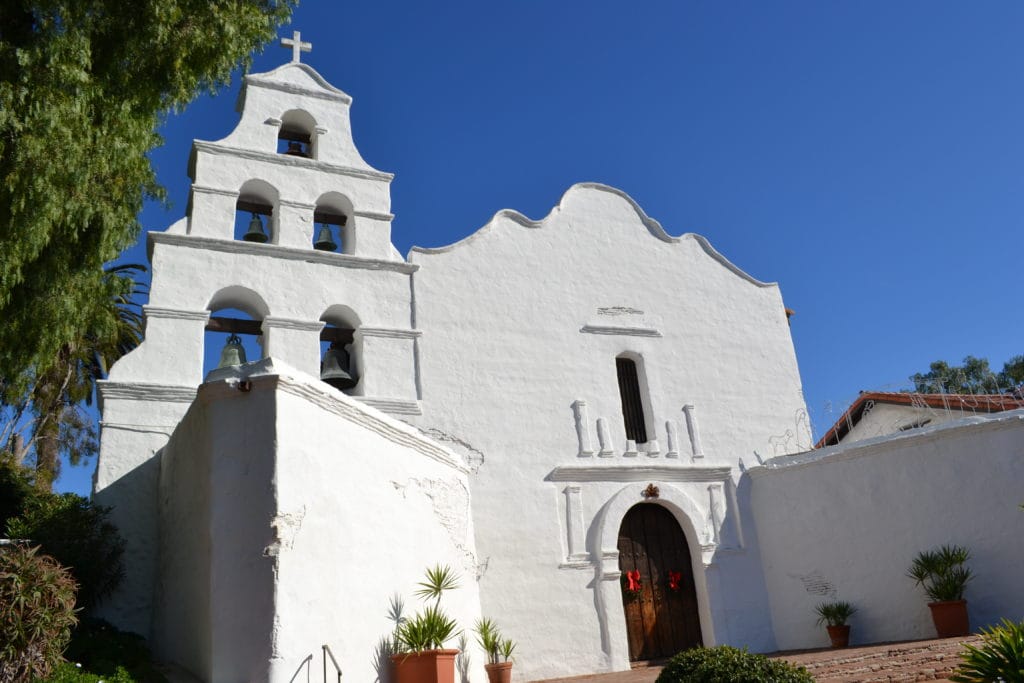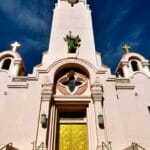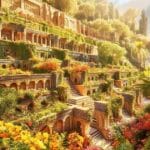Embark on a captivating journey through time as we explore California’s fascinating history through the lens of Mission San Diego de Alcalá. Get ready to uncover ten intriguing facts about this architectural marvel, from its humble beginnings to its pivotal role in shaping California’s identity. Prepare to immerse yourself in the stories and secrets of this iconic landmark.
10 Interesting Facts About Mission San Diego de Alcalá
Ready to travel back in time? Let’s explore Mission San Diego de Alcalá, a place brimming with history and beauty.
- The Trailblazer: Imagine being the first! Mission San Diego de Alcalá wasn’t simply another mission; it was the very first one built in California, kicking off a chain reaction of 21 missions. Talk about making a grand entrance!
- Honoring a Saint: Ever heard of Saint Didacus of Alcalá? Well, this mission was named in his honor and holds the title of the second Franciscan mission established in the Californias – a pretty big deal back in the day!
- The Heart of It All: Think of Mission San Diego de Alcalá as the seed that blossomed into the vibrant city of San Diego we know today. It wasn’t just a place of worship; it was the heart of Spanish exploration and the foundation for a growing region.
- A Blend of Styles: Over time, the mission’s looks changed. It’s like adding new accessories to your favorite outfit! Renovations and restorations brought elements of Spanish and Native American design, creating a unique look that tells a story of cultural fusion.
- A Shift in the Tides: The arrival of the mission significantly impacted the Kumeyaay people who originally called this land home, bringing changes to their culture and way of life.
- San Diego’s Genesis: Picture San Diego without its iconic buildings, bustling economy, and vibrant culture – hard to imagine, right? Mission San Diego de Alcalá played a key role in shaping all these elements, leaving a lasting legacy on the city.
- A Survivor’s Spirit: Earthquakes and fires – oh my! This mission has seen its share of challenges, enduring the test of time. But just like a phoenix rising from the ashes, it was rebuilt time and again, showcasing its resilience and determination to stand tall.
- More Than Just History: This isn’t your average dusty museum! Mission San Diego de Alcalá is a living, breathing testament to faith and history. It’s still an active parish today, buzzing with the energy of its community and keeping its spiritual heritage alive.
- A Window to the Past: Curious about California’s past? A visit to Mission San Diego de Alcalá is like stepping into a time machine. Its breathtaking architecture and serene atmosphere offer a glimpse into a bygone era, inviting you to connect with history.
- A Tapestry of Cultures: Think of Mission San Diego de Alcalá as a beautiful tapestry woven from threads of Spanish, Native American, and American influences. It stands as a powerful symbol of California’s rich and diverse heritage, reminding us of the fascinating interplay of cultures that shaped this region.
What are three interesting facts about Mission San Diego de Alcala?
We’ve already covered some background on Mission San Diego de Alcala, but here are some lesser-known facts that might surprise you:
- It wasn’t always smooth sailing. While Mission San Diego de Alcalá was the first mission in California, things didn’t always go according to plan. Just six years after it was founded, in 1775, a group of indigenous people, frustrated with the mission’s impact on their lives and traditions, revolted and burned the mission to the ground. It’s a stark reminder of the complex and often tumultuous history of the mission system.
- The mission’s location moved… and it wasn’t easy! You might not know that the Mission San Diego de Alcalá you visit today wasn’t in its original location. After the revolt, the mission fathers decided to relocate to a more defensible spot about six miles away. Think about that – they had to move all their belongings, livestock, and building materials using only the technology available in the late 1700s! It probably took a lot of manpower and ingenuity to re-establish the mission in its new home.
- There’s more to discover than meets the eye. Beyond its beautiful architecture and historical significance, Mission San Diego de Alcalá is still an active place of worship and community. It’s home to an active parish, a museum that showcases artifacts from the mission’s long history, and beautiful gardens that offer a tranquil escape from the bustling city. Next time you visit, take some time to explore beyond the main buildings and imagine the lives of the people who lived and worked there centuries ago.
These fascinating facts offer just a glimpse into the rich tapestry of Mission San Diego de Alcalá’s past. It’s a place where history comes alive, and each stone seems to whisper stories of resilience, faith, and the enduring human spirit.
How old is the San Diego de Alcalá Mission?
So, we’ve already established that Mission San Diego de Alcalá is pretty darn old, right? But how old exactly? Well, buckle up, because we’re about to take a trip back to 1769. That’s right, folks; this California landmark has been standing tall since 1769. To put that into perspective, that’s older than the United States itself!
Now, building something as grand as a mission takes time, and San Diego de Alcalá was no exception. While Father Junipero Serra, the superstar of early California missions, laid the first stone in 1769, it took a good 15 years for the mission to reach its full glory in 1784.
Imagine, for a moment, the hustle and bustle of that era. Mission San Diego wasn’t just a pretty face; it was the heart of the community. This was where folks gathered for everything from religious services to trading goods to catching up on the latest gossip. The mission’s farmlands were buzzing with activity, producing crops and raising livestock that fed the community. It’s amazing to think that the very walls we admire today were once a witness to such a vibrant past.
Speaking of those walls, have you ever noticed how thick they are? Those weren’t just for show! Back in the day, life in California wasn’t always peaceful. Those sturdy adobe walls, with their small windows, were strategically designed to protect the mission and its inhabitants from any potential threats. Talk about a fortress of faith!
Today, Mission San Diego de Alcalá stands as a beautifully preserved reminder of California’s rich history. Walking through its arched corridors and sun-drenched courtyards is like stepping back in time. You can practically hear the echoes of laughter, prayers, and the rhythmic clang of blacksmiths’ hammers. It’s a humbling experience, to say the least.
So, there you have it – Mission San Diego de Alcalá, a nearly 250-year-old testament to faith, resilience, and the enduring spirit of California.
Did San Diego de Alcalá Have Animals?
We know Mission San Diego de Alcalá was much more than just a place of worship. It was a bustling center of activity, especially when it came to farming and feeding its many inhabitants. So, did they rely on animals to help make this all work? You bet they did!
Think of it: to keep a mission running smoothly, they needed a reliable source of food, materials for clothing, and ways to get around. This meant raising a whole lot of livestock. We’re talking potentially thousands of animals! Records suggest they had an impressive number of cattle for their meat and milk, sheep for their wool, and horses for transportation and work. Imagine the sights and sounds of those herds!
But it wasn’t just about the big guys. The mission was probably also teeming with other creatures. Dogs would have been essential for herding and protection. Cats likely helped keep the rodent population in check. Chickens provided fresh eggs, while pigs and goats offered additional sources of meat and dairy.
It’s fascinating to picture how animals were woven into the very fabric of mission life. They weren’t just resources; they were probably companions, working partners, and a constant presence in the daily routines of the people who lived and worked there. While we might not have all the exact numbers or details, it’s safe to say that Mission San Diego de Alcalá would have been a very different place without its animal inhabitants!
What is Mission San Diego named after?
So, we’ve been chatting about Mission San Diego, and you might be curious about its name. It’s not just a random bunch of words, you know! Mission San Diego de Alcalá actually gets its name from a pretty important guy, a Spanish Franciscan friar who lived back in the 1400s named Saint Didacus of Alcalá.
Now, Saint Didacus wasn’t just any friar. He was known for being super humble and charitable. People even believed he performed miracles! It wasn’t until 1588 that the church officially recognized him as a saint, which is a pretty big deal.
Fast forward a bit to 1769, and that’s when Father Junípero Serra, another important figure in California history, decided to establish Mission San Diego. This was actually the second mission out of 21 that would eventually dot the California landscape. He chose to honor Saint Didacus by naming the mission “Mission San Diego de Alcalá.”
Today, the mission still stands in San Diego, and it’s not just a historical landmark. It’s still a functioning Roman Catholic parish, a vibrant part of the community where people gather to worship and connect.
What is the oldest mission in California?
If you’re curious about California’s history, the missions are a great place to start. And when it comes to missions, Mission San Diego de Alcalá stands out as the granddaddy of them all. Founded way back in 1769 by the Franciscan friar Junípero Serra, it’s the oldest mission in the entire state! Located right in the heart of San Diego, this mission is like a time capsule, packed with stories and echoes of a bygone era.
The mission’s story didn’t start exactly where it is now. See, they first tried building it on Presidio Hill, figuring it was a good spot to keep an eye on things. But by 1774, they decided to move the whole operation to Mission Valley. It just made more sense – better soil for farming, closer to the San Diego River for water, you get the idea.
Now, Mission San Diego wasn’t just about religion, although that was a big part of it. The mission folks were all about spreading Christianity to the Kumeyaay people who lived in the area. But they were also like the entrepreneurs of their time, turning the mission into a bustling farm. We’re talking fields stretching as far as the eye could see, vineyards bursting with grapes, and more livestock than you could shake a stick at. This agricultural hustle really helped put the region on the map economically.
When you visit Mission San Diego today, take a moment to appreciate its architecture. Those thick adobe walls, the sturdy way it’s all put together, and even the tiny windows placed just so – it all speaks to a different time. They knew how to build things to last back then, and they weren’t afraid of a little hard work. They even built a dam on the San Diego River to make sure the mission always had enough water. Talk about forward-thinking!
Life at the mission wasn’t always peaceful, though. In 1775, there was an uprising that caused some severe damage. But like a true survivor, Mission San Diego picked itself up, dusted itself off, and rebuilt even stronger. And thank goodness it did! Today, it’s not just a historical relic but a living, breathing testament to California’s roots. It’s a church, a museum, and a major tourist attraction all rolled into one.
Here’s a little recap for you:
- Oldest of the old: Mission San Diego de Alcalá officially holds the title of the oldest mission in California, founded in 1769.
- Location, location, location: It started on Presidio Hill but found its forever home in Mission Valley.
- Sharing is caring: The mission played a big part in bringing Christianity to the Kumeyaay people.
- Farming for the win: Mission San Diego’s agricultural success boosted the region’s economy.
- Built to last: The mission’s architecture is a testament to the skills and resourcefulness of its builders.
- Still going strong: Today, Mission San Diego de Alcalá is a vibrant parish, museum, and tourist hotspot, offering a glimpse into California’s fascinating past.
Was San Diego de Alcalá Ever Moved?
So, we’ve been exploring the history of Mission San Diego de Alcalá, this super important landmark in California. Remember how it was founded in 1769 by Father Junípero Serra? Well, just a few years later, something interesting happened. You see, the mission fathers realized their original location wasn’t so great. Can you guess why?
They were running out of water! Imagine trying to build a whole community with limited access to such a vital resource. It just wouldn’t work! So, they made a big decision. They packed up and moved the entire mission in 1774. It wasn’t a huge move, just about six miles east to a spot closer to the San Diego River. This new location offered a much more reliable water source, which, as you can imagine, was a game-changer!
Think about it – moving an entire mission back then was no easy feat! It probably involved a lot of hard work and planning. They had to transport building materials, livestock, and all their belongings. This move shows how adaptable and resilient those early missionaries were. They knew what they needed to do to survive and thrive and weren’t afraid to make a change, even a big one!
This move had a lasting impact. Being closer to the river allowed the mission to flourish. They were even able to build a dam on the San Diego River in 1807, making their water supply even more secure. This goes to show how important that one move was in shaping the future of Mission San Diego de Alcalá into the landmark we know and love today.
What are some fun facts about the San Fernando Mission?
Want to learn about a different mission? Let’s explore the San Fernando Mission, a place full of surprises! Did you know it was founded way back in 1797 by a priest named Father Fermín Francisco de Lasuén? That makes it the 17th mission built in California, out of 21 total. Talk about being part of history!
And get this – the church at Mission San Fernando? It’s massive! It’s actually the biggest church out of all the California missions. You can really see that Spanish colonial style they were known for.
The coolest part? People still go to church there today! It’s still an active parish, which is amazing considering how old it is. It’s like a living, breathing link to the past.
Back in the day, the mission was a big deal for travelers on El Camino Real. It was a place to rest and recharge. You can imagine all the different cultures mixing and mingling there – the Native Americans and the Spanish settlers. It must have been a sight to see!
Today, you can visit the mission’s museum and learn even more about its past. They have all sorts of artifacts and stories about the missionaries and the native people who lived there. It’s worth checking out if you’re ever in the area!
What are some interesting facts about Puerta de Alcalá?
Let’s travel to Madrid, Spain, and learn about Puerta de Alcalá! This gate’s story is fascinating!
For starters, imagine Madrid way back when, not the bustling city it is now, but a place huddled within walls. Puerta de Alcalá was like a grand “Welcome” sign, marking the end of those walls and the beginning of the open road. It was a powerful symbol, showing everyone that Madrid was growing and changing with the times.
Now, let’s talk style. You can’t help but notice the elegant mix of old and new in Puerta de Alcalá’s design. It’s got that classic Greco-Roman vibe, with a touch of Baroque flair thrown in for good measure. And those three arches? They weren’t just for looks. They were like the city’s front doors, each one leading to a different road out of Madrid.
Take a closer look, and you’ll see all sorts of intricate details carved into the stone. Roman gods and goddesses, symbols of victory and triumph – it’s like a history book carved right into the gate itself! These details remind us that Puerta de Alcalá has seen it all – grand royal parades, impressive military marches, even passionate political gatherings. It’s been a silent witness to Madrid’s story, standing tall through it all.
And get this – even today, Puerta de Alcalá isn’t just some dusty old monument. Nope, it’s still the place to be! From lively festivals to grand celebrations, this gate continues to be a central stage for Madrid’s vibrant culture. It’s a reminder that even in a city that’s always evolving, some things remain timeless symbols of beauty, history, and the enduring spirit of Madrid.
What are three interesting facts about Mission Santa Clara de Asís?
Let’s head back to California and learn about Mission Santa Clara de Asís! One thing that makes it stand out is its unique setting. Picture this: a historic mission right in the middle of a bustling university campus. That’s Mission Santa Clara de Asís! It’s actually the only mission in all of California that can claim to be on a university campus, which makes it a pretty big deal.
And speaking of unique, the mission is also home to a very special bell, a gift from none other than King Carlos IV of Spain. This wasn’t just any old bell, it was a symbol of the close ties between the mission and the Spanish crown, a tangible link to a powerful past.
But perhaps the most amazing thing about Mission Santa Clara de Asís is its resilience. Over the years, the mission church has been rebuilt a staggering five times! Just imagine the dedication and hard work it took to keep rebuilding, to keep the spirit of the mission alive through fires, earthquakes, and who knows what else! It’s a testament to the people who believed in its importance and were determined to see it stand the test of time.
So, as you can see, Mission Santa Clara de Asís is more than just a pretty building; it’s a living, breathing piece of history, intertwined with the energy of a university and the echoes of a royal past.
When was San Diego de Alcala destroyed?
So, we’ve been talking about Mission San Diego de Alcalá, the granddaddy of all the missions in California, founded way back in 1769. It’s seen a lot in its time, that’s for sure! Now, you might be wondering about times it faced some serious trouble – like, was it ever completely wiped out?
To answer that directly: While the mission definitely had its share of close calls, it was never completely destroyed. But hold on, it wasn’t all smooth sailing either. Remember that uprising in 1775? The Kumeyaay, who weren’t exactly thrilled about the whole mission situation, attacked the place, and, sadly, Father Luis Jayme lost his life. They did some damage, setting buildings on fire, but the mission itself? It held strong.
Then there were those pesky earthquakes, always a worry in California. And fires too – those adobe walls, while tough, weren’t fireproof. Over the years, there were definitely times when parts of the mission were damaged, even badly. But each time, like a phoenix rising, they rebuilt.
And that’s part of what makes Mission San Diego de Alcalá so fascinating today. It’s not just a pretty building; it’s a survivor. Standing there, you’re looking at centuries of history, of struggles and rebuilding, all layered on top of each other. Pretty cool, huh?
Ready to dive into more fascinating history? If you’ve ever wondered about the man who united England, be sure to check out our article on 10 facts about King Athelstan. For those interested in the history of poverty and social welfare, we have a fascinating piece on 10 facts about workhouses. And for anyone who’s ever been intrigued by the ancient world, we highly recommend our article on 10 interesting facts about the Hanging Gardens of Babylon.
- Star Ring Trends: Etsy vs Amazon - March 28, 2025
- Boost Pollinator Habitats: Baby Blue Eyes Sustainable Farming Guide - March 28, 2025
- Protect Big Black Bears: Effective Conservation Strategies - March 28, 2025
















